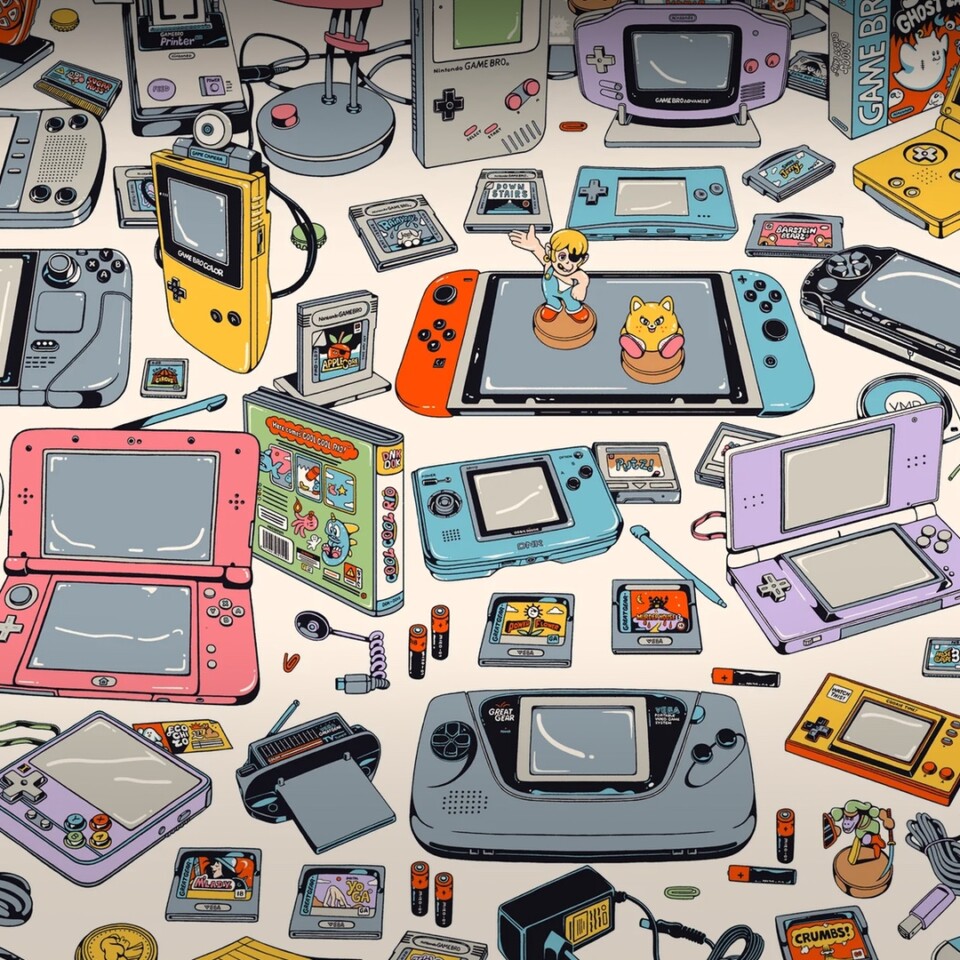My coffee table doesn’t have a lot of room for coffee cups these days.
Finding a spot for a nice cup of Café De Altura En Grano has become an increasingly tricky task, given the number of gaming-related hardbacks I have acquired and displayed to prove that VIDEO GAMES ARE AN ART FORM!!!! to my friends and family.
For a long time, art books and guides were the mainstays of my obsession with glossy, large-format video game publications. Increasingly, however, more books are delving into the history of a specific topic, franchise, or publisher. Some, like The Game Console 2.0, focus on photography to bring their subjects to life, with just a sprinkling of text for context and flavour. Other favourites, like Cook and Becker’s sublime Pac-Man – Birth of an Icon or BioWare: Stories and Secrets from 25 Years of Game Development, are treasure troves of archival material, interviews, and historical analysis.
A Handheld History straddles the line between the two, balancing high-end production values, photography and illustrations with essays from a range of contributors, including Jeff Grubb, Jonathan Traynor, Janet Garcia and Kevin Kenson, to name just a few.
Despite its title, the book does not try to shed light on the historical development of portable gaming systems. This is not the story of the engineers who created the Game Boy, PlayStation Portable, Nintendo Switch and Steam Deck (among many other platforms) but the stories of the people who play and treasure these devices. This collection of experiences and nostalgic reflections is perhaps better described as a lived history. These are the tales of kids slumped in the back seat of a car, trying to catch passing street lights to illuminate a Game Boy. And of the pleasure found in repairing a Sega Game Gear. And how the PS Vita’s eclectic game library provided a source of emotional support during the darkest of times.

A Handheld History‘s production values and design are a worthy tribute to these stories. This 272-page tome is handsomely bound and printed on deliciously tactile 130 gsm stock. The use of photography is strong throughout, with artistic shots of system variants, cover art and accessories. And if the prospect of a double-page spread of Joy-Con gives you the feels, it’s an easy book to recommend.
The accompanying cover art and illustrations by Stephen Maurice Graham are also impressive. Each piece encapsulates the feelings of joy and playfulness that come with portable gaming, whether it’s trading Pokémon with your mates on the school bus or exploring vast worlds on a tiny matrix screen from the sanctuary of your bed. Graham’s illustrations capture that essence wonderfully, perhaps more so than the text itself.

The essays are, for the most part, evocative recollections about the pleasures and quirks of owning handheld game consoles. The entries focused on early handheld systems are particularly rose-tinted and affectionate, especially those that celebrate the innovations and peculiarities of Nintendo’s idiosyncratic approach. And Jeff Grubb’s ode to the Steam Deck is an outright marriage proposal.
It’s also good to see coverage of some more obscure platforms, as well as a few outright failures. It’s reassuring to know that the Game.com and Mega Duck are not completely forgotten. Jason Brown’s essay on the launch of the ill-fated – but quietly innovative – Gizmondo is a standout piece and a fascinating recap of one of the industry’s wildest ventures.

Occasionally, the text can get a little bogged down in the perceived issues of a system rather than celebrating its achievements. The Nintendo Switch entry is oddly downbeat, for example, considering the console’s undoubted impact and success. And more than a few sweeping assumptions are thrown around as fact, which is disappointing given the potential for the book to become a useful reference source.
A Handheld History is clearly a labour of love, and it still gets my recommendation, especially if you have childhood experiences of the systems covered. At its best, it successfully captures the unique magic of handheld gaming, showing how battery life, screen limitations, and other technology constraints can be overcome to create some of the best games ever made. It’s a relatable and nostalgic journey that, with a little editing and fact-checking rigour, could have achieved SP status.
Images: Expanse. Lost in Cult
Book: A Handheld History
Author: Various (including Alex Olney, Bob Wulff, Brandon Saltalamacchia, Janet Garcia, Raul Higuera and more)
Publisher: Expanse / Lost in Cult
Publication Date: October 17, 2023






